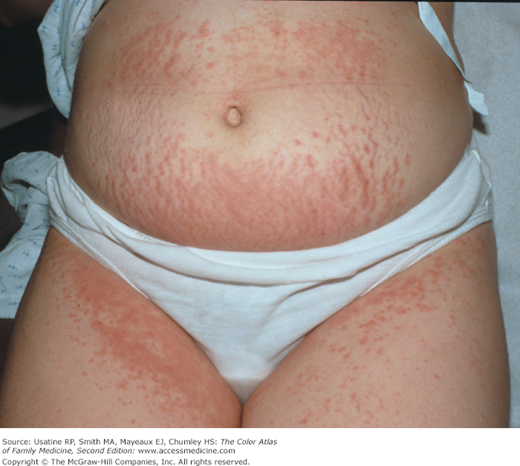Patient Story
A 26-year-old pregnant woman presents at 36 weeks of gestation with a progressive itchy rash. The rash started within the abdominal striae (Figure 75-1) and spread to her proximal extremities. This is her first pregnancy and she has never had any rashes like this before. The itching “is maddening.” The patient is diagnosed with pruritic urticarial papules and plaques of pregnancy (PUPPP) and treated with topical steroids and oral antihistamines.
Introduction
PUPPP is a dermatosis of pregnancy characterized by a papulovesicular or urticarial eruption on the abdomen, trunk, and limbs. Other than maternal itching, PUPPP poses no increased risk of fetal or maternal morbidity.1
Synonyms
Epidemiology
- The incidence of PUPPP is 1 out of 160 to 1 out of 300 pregnancies, making it the most common defined dermatosis of pregnancy.2
- Nulliparous patients account for more than 75% of patients with classic PUPPP.3
- PUPPP is also more common with multiple gestations, possibly because of increased abdominal distention or higher hormone levels.4
Etiology and Pathophysiology
- The etiology of PUPPP is unknown. PUPPP is more common with excessive stretching of the skin, possibly because of damage to connective tissue, which could result in exposure of antigens that trigger an inflammatory response.2,5 The disease may also represent an immunologic reaction to circulating fetal antigens.
- Onset of PUPPP is usually late in the third trimester, but may develop postpartum.1,3 There are case reports of first and second trimester disease.3 Pruritus may worsen after delivery, but generally resolves by 15 days postpartum. The PUPPP may resolve prior to delivery.
Risk Factors
Diagnosis
PUPPP is usually diagnosed by its characteristic findings on history and physical examination. PUPPP typically presents with erythematous papules and plaques within striae with periumbilical sparing (Figures 75-1 and 75-2). Extreme pruritus is a hallmark of the disease and is present in all patients.1
Stay updated, free articles. Join our Telegram channel

Full access? Get Clinical Tree



